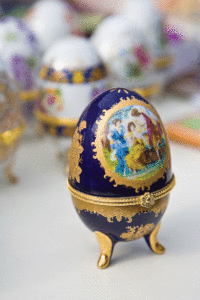
Faberge eggs are famous for their detail and magnificence.
A Faberge egg was named after Russian jewelry designer and manufacturer Peter Carl Faberge.
Around 70 intricate, jewel-encrusted, mechanical and often detailed works were famously created for Tsar Alexander III and Nicholas II of Russia for their children, wives and mothers.
Today, some are priceless, and have a long history that involves beauty of artistry, tragedy and collection.
The eggs are famous for their detail and magnificence, including the original 52 “Imperial” eggs that were made for the Russian royal family, that included mechanical workings, priceless jewels and intricate designs in miniature.
Faberge painstakingly designed these and others, between the years of 1885 and 1917.
The original intent of the Imperial eggs were decadent Easter gifts of a royal nature.
The first egg was given to Empress Maria Feodorovna in 1885, commissioned by Tsar Alexander III.
He had an Easter egg made for her that involved being created from a foundation of gold.
It was called the Hen Egg, and the “shell” opened to reveal a golden hen that opened up to a tiny diamond replica of the Imperial crown, which also contained rubies.
The royals were so delighted they became obsessed with these Easter gifts, and the process had begun.
When Tsar Alexander died, his son Nicholas carried on the tradition, ordering eggs each year at Easter for his family.
Peter Carl Faberge was given full creative license to design and create the eggs, the only rule being that each contain a surprise.
The eggs became more and more unique and lavish as each year passed, and a team of craftsmen were chosen to carry out the miniature, delicate work.
Many private collectors and wealthy patrons commissioned Faberge to have their own eggs made after viewing the wonders of the intricated, bejeweled, golden creations of the royals.
Some of the special eggs created are unique and wondrous.
Eggs such as Lillies of the Valley, Cloverleaf, Gatchina Palace, Pelican and more.
Just one example of the mastery and mindblowing designs of the eggs can be found in the egg, “Bay Tree,” created in 1911 by Faberge for Nicholas II to give to Dowager Feodorovna.
When you turn the tiny piece of fruit on the outside of the orangery bay tree, the songbird rises and flaps its wings, turns its head, and opens and closes its beak while it sings.
This is done with mechanical systems inside triggered when the fruit is turned, promoting a hinge inside to activate the bird.
The Russian royal family fled their palaces and ultimately were put to death during the Bolshevik uprising and revolution in 1918.
The collections and belongings of the royal family were looted by war, and some of the eggs were stolen and lost to damage.
The Faberge family and workshops fled St. Petersburg during this time, and in the following years, the Faberge trademark was sold several times, and the egg-related merchandise, sold under the Faberge name is still sold today, in a lesser, more mass produced capacity than the wonders of the Imperial reign.
Today, about 69 of the roughly 75 Imperial eggs have survived looting and war.
They can be found in museums all over the world, in private collections, and locally, the Walters Art Museum in Baltimore has a few on display for viewing, and Hillwood Estate in Washington also owns a few.
To see their intricate detail and artistry is a thing of wonder.
(Editor’s note: DeeDee Wood is the owner of Black Cat Curiosities Art and Antiques in Easton, Md., located at 24B Harrison St.)



